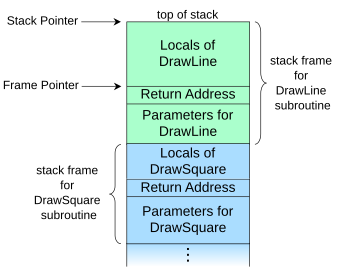What exactly is the base pointer and stack pointer? To what do they point?
Using this example coming from Wikipedia, in which DrawSquare() calls DrawLine():

(Note that this diagram has high addresses at the bottom and low addresses at the top.)
Could anyone explain to me what ebp and esp are in this context?
From what I see, I'd say the stack pointer points always to the top of the stack, and the base pointer to the beginning of the current function? Right?
edit: I mean this in the context of Windows programs.
edit2: And how does eip work, too?
edit3: I have the following code from MSVC++:
var_C= dword ptr -0Ch
var_8= dword ptr -8
var_4= dword ptr -4
hInstance= dword ptr 8
hPrevInstance= dword ptr 0Ch
lpCmdLine= dword ptr 10h
nShowCmd= dword ptr 14h
All of them seem to be dwords, thus taking 4 bytes each. So I can see there is a gap from hInstance to var_4 of 4 bytes. What are they? I assume it is the return address, as can be seen in the diagram from Wikipedia.
(editor's note: removed a long quote from Michael's answer, which doesn't belong in the question, but a followup question was edited in):
This is because the flow of the function call is:
- Push parameters (hInstance, etc.)
- Call function, which pushes return address
- Push ebp
- Allocate space for locals
My question (last one, I hope!) now is, what exactly happens from the instant I pop the arguments of the function I want to call up to the end of the prolog? I want to know how the ebp, esp evolve during those moments (I already understood how the prolog works, I just want to know what is happening after I pushed the arguments on the stack and before the prolog).
esp is as you say it is, the top of the stack.
ebp is usually set to esp at the start of the function. Function parameters and local variables are accessed by adding and subtracting, respectively, a constant offset from ebp. All x86 calling conventions define ebp as being preserved across function calls. ebp itself actually points to the previous frame's base pointer, which enables stack walking in a debugger and viewing other frame's local variables to work.
Most function prologs look something like:
push ebp ; Preserve current frame pointer
mov ebp, esp ; Create new frame pointer pointing to current stack top
sub esp, 20 ; allocate 20 bytes worth of locals on stack.
Then later in the function you may have code like (presuming both local variables are 4 bytes)
mov [ebp-4], eax ; Store eax in first local
mov ebx, [ebp - 8] ; Load ebx from second local
FPO or frame pointer omission optimization which you can enable will actually eliminate this and use ebp as another register and access locals directly off of esp, but this makes debugging a bit more difficult since the debugger can no longer directly access the stack frames of earlier function calls.
EDIT:
For your updated question, the missing two entries in the stack are:
nShowCmd = dword ptr +14h
hlpCmdLine = dword ptr +10h
PrevInstance = dword ptr +0Ch
hInstance = dword ptr +08h
return address = dword ptr +04h <==
savedFramePointer = dword ptr +00h <==
var_4 = dword ptr -04h
var_8 = dword ptr -08h
var_C = dword ptr -0Ch
This is because the flow of the function call is:
- Push parameters (
hInstance,PrevInstance,hlpCmdLine,nShowCmd) - Call function, which pushes return address
- Push
ebp - Allocate space for locals
- Why does an empty preprocessor command still evaluate to something?
- How to implement variable sized array within C struct
- Character array typecasting to integer
- How can I exclude non-numeric keys? CS50 Caesar Pset2
- How to get the sign, mantissa and exponent of a floating point number
- Why do MCU libraries use logic operations instead of bitfield structs?
- What kind of implementation can I use for a static associative array on a vintage system with very limited resources?
- Determine libraries to link against for a windows library function?
- Passing macro values to arm linker that places variable at a specific location
- running a program with wildcards as arguments
- How to perform addition of two vectors of 8-bit integers with a single addition in C/C++
- GNU RISC-V Embedded GCC throws "x ISA extension `xw' must be set with the versions" error
- Counting pulses using a swiss flow meter with an Arduino, how is it done?
- How to create a folder in C (need to run on both Linux and Windows)
- Is there any way to compute the width of an integer type at compile-time?
- How can I initialize all members of an array to the same value?
- Is C notably faster than C++
- How to get the Windows SDK version number a program is compiling with at compile time
- Confused by difference between expression inside if and expression outside if
- Equivalent of atoi for unsigned integers
- k&r: Exercise 1-18. Program takes input but doesnt produce any output?
- Using in C thrd_sleep() to either wait for time or interrupt by signal. Example?
- How can I compute `exp(x)/2` when `x` is large?
- c programming: answer always equates to 0
- Is it possible to access a parameter of a function from another function in C?
- Will this expression evaluate to true or false (1 or 0) in C?
- What Is the Return Value of strcspn() When Str1 Does not Contain Str2?
- Mapping a numeric range onto another
- Signalled and non-signalled state of event
- Why is faster to do a branch than a lookup?